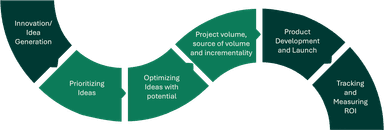"Innovation is the only way to win" - Steve Jobs.
Almost every business book and masterclass touches on the significance of innovation in one way or another. Steve Jobs' quote is a testament to this; after all, Apple's history proves what innovation can do for a brand.
But innovation isn't always the "promised land" it’s perceived to be. Businesses spend millions on innovation, yet the majority of innovations fail to deliver to projected performance. And failure can even reach brands that exist in one of the most innovation-driven industries; just remember Samsung's explosive Galaxy S7s.
This discussion got us thinking: is it possible to accurately calculate the return on investment (ROI) of innovation? And is it even worth it?
Let's start with the math first.
A quick refresh on ROI
If you've worked in the business world for a while (or just opened a book on business management), you're probably familiar with ROI.
For those that want a refresher, return on investment (ROI) measures the effectiveness of an organization's investment into something (e.g., a product or service). There are many ways to calculate ROI, but the most popular is this:
ROI = Net income / Cost of investment x 100.
The return on innovation investment (R2I) measures how effectively an organization turns R&D expenses into profit when invested in a new product/service.
As a marketer or product manager, you might use R2I to prove to your CEO that it’s worth it to invest a budget into a campaign that’s already converting well, or a feature that needs to be tweaked. It gives senior leaders tangible evidence of success.
Why people have a beef with measuring the ROI of innovation
Innovation efforts are complicated and iterative
As experts in helping brands innovate better, we know that innovation can mean many things: huge, transformational pieces of work and tiny changes to existing flavors, pack designs, go-to-market messages, etc.
It may be easy to calculate how much money you spent on a product launch and how many sales you generated. But how do you track the impact of changing one word on your packaging? It gets harder to separate such minor innovative adjustments from the whole picture.
And it’s worth noting, too, that innovation efforts aren’t just about immediate sales. Innovation can serve the purpose of keeping your brand’s products/services in line with the competitive market or simply signal to consumers that you’re forward-thinking.
That's why the success of any particular product or service innovation is so hard to measure.
The numbers don't always add up
Calculating ROI sounds easy: you can just take how much you've spent and how much you've earned and stick it into a calculator. But how do you measure the ROI of something as amorphous as ‘business innovation’?
Think of the "cost" value in the equation. While some costs may be fixed (e.g., product development), others may vary depending on the number of people you need to hire, the time required to test the innovation, and the project scale (e.g., a disruptive innovation vs. a line extension).
As for the "net income" or profit, how do you know how much you earned? Time is one factor that might affect your calculations – e.g., at first, your innovation might be super profitable, but in a few weeks, it might lose stagnate.
Google Glasses were predicted to be one of the company's most significant breakthroughs. Yet after its launch in 2013, it became the brand's biggest failure. Recently, however, Google announced they're working on new AR devices that put "real-time translation and transcription directly in your line of sight." Sounds familiar, right? So, if this new AR device is successful, how do we account for the previous Google Glasses work that didn’t fare so well? And how should Google measure the profits of that new device?
All these "what if" speculations prove that innovation is a tricky thing to measure.
Innovation = insurance
We can’t take credit for this argument, but we do agree that innovation is like insurance. Here's what that means.
Can you tell me how much return you get from your car insurance? The answer is no, not really. Why? Because you don't get any money from getting car insurance, you only lose money initially. Insurance is there if something unforeseen happens to your car. It acts as your protection.
The same logic can be applied to innovation. When you innovate, there's always some money to lose. So, it's just a question of how much you spend initially vs how much you might earn in future. In this light, spending upfront protects you from competitors’ eating your lunch.
If the return on investing in something new will always be negative upfront, why would you even spend your time measuring the impact going forwards?
Well, we have some thoughts on all 3 of these arguments.
Why we think measuring ROI in innovation still matters
Michael Edwards, our Chief Growth Executive and Co-Founder, spent over 20 years helping brands innovate successfully. To further the argument that measuring the ROI of innovation matters, he uses an example:
"Let's say you launched a new cookie and got a profit of $1 million. You're happy, your executives are happy, it's a great success. But then what if you realize that you spent $5 million to develop that cookie? The picture is not quite so rosy. That's why ROI of innovation is still important – it helps you understand how much you got out of your investment."
You might be thinking, okay – but the ROI of innovation is clearly negative in the argument above. Michael argues that doesn’t change our argument:
”Saying, "I know it will be negative, so there's no point in investing in innovation," doesn't make sense. The real question should be, "How negative is it?". If the investment didn't bring you any returns in the long run, then yes, it wasn't successful. But if it brought some sort of positive outcome, you might be in a good spot. It's all about long-term versus short-term gains."
We’ve all read the stories where BlackBerry execs laughed at Apple's overpriced phones. Or how Kodak was forced to file for bankruptcy when people switched to digital cameras. Ironically, Kodak's researchers proposed a digital camera in the 70s. But the executives either didn't think it had potential.
While it's easy to say "innovation is optional so let's just focus on something else," it can cost a brand everything. It takes time for innovation to reap rewards.
How Upsiide and Dig Insights fit into this conversation
We've talked a lot about how challenging it is to calculate the ROI of innovation. But that's why Upsiide and Dig Insights exist – we help brands get the most out of their innovation money.
If we were to explain how the brands work together throughout the innovation process, it would look something like this:

Innovation and idea generation are part of Dig Insights' realm. Our analysts conduct foundational research and lead a process to translate that learning into a large set of potential innovations.
Prioritizing ideas, optimizing those with potential, and projecting volume, source of volume and incrementality are Upsiide's strengths. Our platform can identify ideas with the most potential to succeed, provide diagnostics on stronger ideas, and predict how those ideas will perform in the market.
It's worth mentioning that Upsiide recently launched its brand-new Market Simulator, which can forecast how your innovation will perform against what's already in the market. The tool helps clients to see where volume is sourcing from and make educative decisions.
Dig re-enters the picture when it comes to understanding the “why” behind the data.
Paul Gaudette, our CEO and Co-Founder, explains:
"There's always a place for ROI of innovation in the business world. If I needed to persuade a retailer to sell my product, I'd need real numbers in my hands. Upsiide creates a business case for your innovation with predictive data. And Dig interprets the data to develop a full-fledged strategy that tracks how many people bought your innovation, how it ranks against what's in the market and how many shares you steal from your competitors. Measuring these things is enough to ensure that other people pick up your innovation."
To conclude
It’s worth measuring the ROI of innovation – even if it’s negative for some time. Innovation efforts, if done well, can be the reason your brand stays relevant and profitable. We’d like to suggest a tiny change to Steve Jobs' quote; we say: "Innovation and measuring its ROI are the only ways to win."




